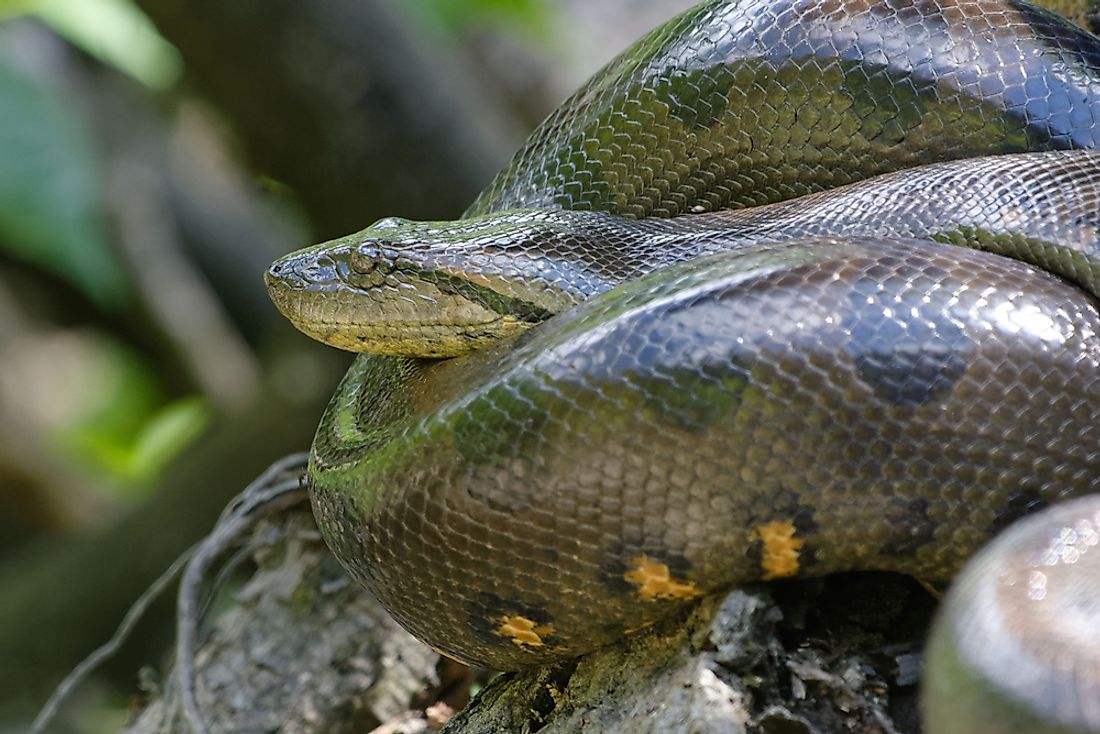Where Do Anacondas Live?

Anacondas are large snakes of the genus Eunectes that are mainly found in the tropical rainforests of South America. There are four species of anaconda, namely the Bolivian Anaconda, Darkly-Spotted Anaconda, Yellow Anaconda, and the Green Anaconda. Anaconda snakes belong to the boa constrictor family of snakes and are the longest and heaviest snakes in the world. They feed mainly on birds, mammals, reptiles, and fish. Anacondas are non-venomous, and their bites are rarely fatal. Anacondas kill their prey by coiling their large bodies and squeezing to suffocate and break all the victim's bones. They are also known to pull their victim into the water and drown them. Anacondas do not hunt for several weeks after having a meal, and the period of digestion depends on the size of the prey.
Where Do Anacondas Live?
Green Anaconda
The Green Anaconda (Eunectes murinus) which is commonly known as the water boa is the longest and the largest species. The snake weighs about 550 pounds and grows to a length of about 17.1 to 30 feet. The snake has an olive green coat that is overlaid by black blotches. This type of snake has two subspecies, namely Eunectes murinus murinus and Eunectes murinus gigas. Green anacondas are mainly nocturnal and only come out at night to hunt. The species is primarily found near or in calm waters or swampy areas in tropical South America. The Green Anaconda is sluggish on land but is quick and agile in water. The snakes prefer living in water as it supports its weight and enables to approach unsuspecting prey quickly. The native habitat of the Green Anaconda is east of the Andes in north-central South America. They are found in numerous South American countries, namely Ecuador, Colombia, Venezuela, Guyana, Suriname, French Guiana, Brazil, Peru, Bolivia, Paraguay, and the island of Trinidad.
Yellow Anaconda
The Yellow Anaconda (Eunectes notaenus), also known as the Paraguayan anaconda, is mainly found in the southern tropical region of South America. The Yellow anaconda can be found in Paraguay, Bolivia, northeastern Argentina, and southern Brazil. The Paraguayan anaconda has a yellowish, golden tan, or greenish yellow coat with spots, blotches, saddles, or streaks of dark brown or black. The snake attains a length of about 10.8 to 14.4 feet and weighs between 55.1 and 77.1 pounds. The Yellow Anaconda prefers a swampy habitat or one with slow moving streams and rivers. They prey on a wide variety of prey and are known to be unpredictable. The snakes can be dangerous to human beings due to their unpredictable nature.
Dark-Spotted Anaconda
The Dark-Spotted Anaconda (Eunectes deschauenseei), also commonly known as the De Schauensee’s anaconda, is non-venomous. The snake is mainly found in northeastern South America in areas such as Guyana, coastal French Guiana, and northeastern Brazil. The snakes’ habitat includes swamps and seasonal-flooded wetlands. Although the dark-spotted anaconda has a fairly extensive range, it is unknown how habitat loss and degradation is impacting the species resulting in a listing of "data deficient" by the IUCN.
Bolivian Anaconda
The Bolivian Anaconda (Eunectes beniensis), also known as the Beni anaconda, is a species of boa that is commonly found in Bolivia’s province of Beni. The Bolivian anaconda has also been spotted in the neighboring provinces of Santa Cruz and Pando in Bolivia as well as in Brazil. The snake is non-venomous and grows up to 13 feet. The Bolivian anaconda prefers living in a swampy flooded or muddy aquatic habitat. Due to the extended range of the Bolivian anaconda in relatively untouched environments, the IUCN has listed the species as "least concern".
Conservation Of Anacondas
The Green Anaconda is fast becoming one among the numerous endangered species in the world. The rapid decline in the species is fueled by deforestation, habitat loss, and human-wildlife conflict. The human-wildlife conflict is driven by fear that Green anacondas prey on humans which is yet to be factually confirmed. Anacondas are also hunted for their skin and as a source of protein for communities living near their habitats. Currently, conservation efforts focus on learning the biology and behavior of the Green anaconda to enable programs for managing and protecting the species.











